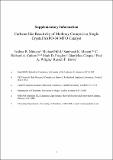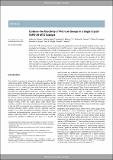Files in this item
Carbene-like reactivity of methoxy groups in a single crystal SAPO-34 MTO catalyst
Item metadata
| dc.contributor.author | Minova, Ivalina | |
| dc.contributor.author | Buehl, Michael | |
| dc.contributor.author | Matam, Santhosh | |
| dc.contributor.author | Catlow, C. Richard A. | |
| dc.contributor.author | Frogley, Mark | |
| dc.contributor.author | Cinque, Gianfelice | |
| dc.contributor.author | Wright, Paul A. | |
| dc.contributor.author | Howe, Russell | |
| dc.date.accessioned | 2023-02-21T00:39:26Z | |
| dc.date.available | 2023-02-21T00:39:26Z | |
| dc.date.issued | 2022-04-07 | |
| dc.identifier | 278132706 | |
| dc.identifier | 05705441-7c08-4c11-b693-23e4dbf38c92 | |
| dc.identifier | 000760912400001 | |
| dc.identifier | 85127034724 | |
| dc.identifier.citation | Minova , I , Buehl , M , Matam , S , Catlow , C R A , Frogley , M , Cinque , G , Wright , P A & Howe , R 2022 , ' Carbene-like reactivity of methoxy groups in a single crystal SAPO-34 MTO catalyst ' , Catalysis Science & Technology , vol. 12 , no. 7 , pp. 2289-2305 . https://doi.org/10.1039/D1CY02361F | en |
| dc.identifier.issn | 2044-4753 | |
| dc.identifier.other | ORCID: /0000-0002-4243-9957/work/109315792 | |
| dc.identifier.other | ORCID: /0000-0002-1095-7143/work/109315952 | |
| dc.identifier.uri | https://hdl.handle.net/10023/27018 | |
| dc.description | Funding: IBM and PAW would like to thank the EPSRC and CRITICAT Centre for Doctoral Training for Financial Support (PhD studentship to IBM EP/I017008/1), and supplementary equipment grant EP/L016419/1]. The UK Catalysis Hub is thanked for resources and support provided via membership of the UK Catalysis Hub Consortium and funded by EPSRC (grants EP/I038748/1, EP/I019693/1, EP/K014706/1, EP/K014668/1, EP/K014854/1, EP/K014714/1 and EP/M013219/1). | en |
| dc.description.abstract | Synchrotron FTIR microspectroscopy coupled with mass spectrometric analysis of desorbed products has been used to investigate the initial stages of the methanol to olefins (MTO) reaction in single crystals of SAPO-34. Surface methoxy groups (SMS) are key to initial dimethylether (DME) and subsequent carbon–carbon bond formation. Deprotonation of SMS is the critical first step in direct olefin formation at low temperatures and DME is not involved in the carbon–carbon forming step. Experiments with CD3OH confirm the deprotonation step and show an inverse kinetic isotope effect consistent with irreversible deprotonation. The subsequent formation of alkoxide species, which are the precursors of the olefinic hydrocarbon pool present in working MTO catalysts, is initiated via insertion of surface carbene-like species into adjacent SMS. The observed induction period for this process is determined by the limited mobility of SMS and/or carbene species. Olefins formed from cracking of the alkoxide species then transmit carbon–carbon bond formation through the SAPO-34 by rapid diffusion and reaction with further SMS. Acetyl species seen with methanol at higher temperatures support the insertion of CO into SMS suggested in the literature, but these species do not play a role in direct olefin formation. | |
| dc.format.extent | 17 | |
| dc.format.extent | 2352783 | |
| dc.format.extent | 1662072 | |
| dc.language.iso | eng | |
| dc.relation.ispartof | Catalysis Science & Technology | en |
| dc.subject | QD Chemistry | en |
| dc.subject | DAS | en |
| dc.subject | MCC | en |
| dc.subject.lcc | QD | en |
| dc.title | Carbene-like reactivity of methoxy groups in a single crystal SAPO-34 MTO catalyst | en |
| dc.type | Journal article | en |
| dc.contributor.sponsor | EPSRC | en |
| dc.contributor.institution | University of St Andrews. EaSTCHEM | en |
| dc.contributor.institution | University of St Andrews. School of Chemistry | en |
| dc.identifier.doi | 10.1039/D1CY02361F | |
| dc.description.status | Peer reviewed | en |
| dc.date.embargoedUntil | 2023-02-21 | |
| dc.identifier.grantnumber | EP/L016419/1 | en |
This item appears in the following Collection(s)
Items in the St Andrews Research Repository are protected by copyright, with all rights reserved, unless otherwise indicated.


